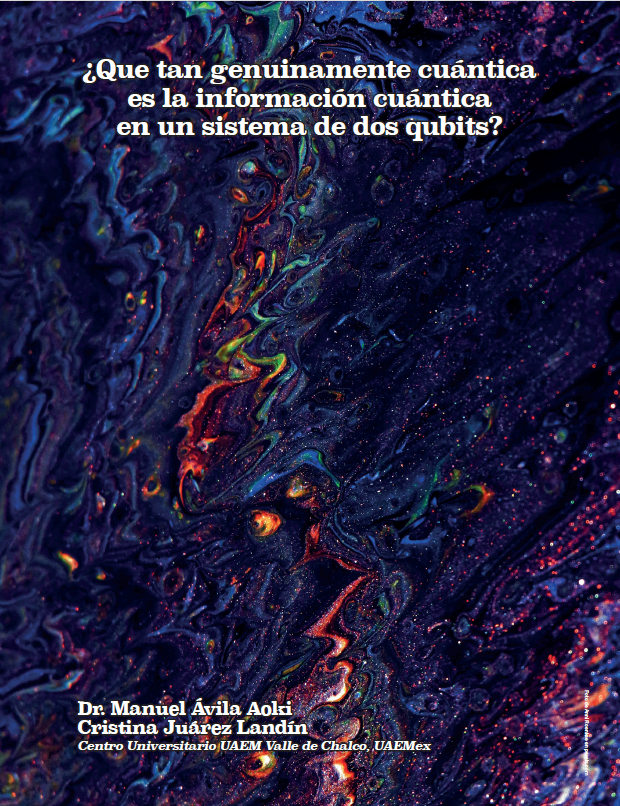¿Que tan genuinamente cuántica es la información cuántica en su sistema de dos qubits?
Abstract
coherence, it is considered a two qubits systems exposed to a common reservoir at very low temperatures. Quantum Information associated to the two qubits system has both a classical contribution and a quantum contribution . It is derived the respective expression for both classical correlations and quantum correlations as a function of time. It is considered the case of remote times (t→∞). In such a situation the genuinely quantum limit where the classical correlations vanish and then Quantum Information is genuinely quantum is found. It is shown that the concept of conservation behind generation (loss) of Quantum Information will be proportional to energy conservation of the system at constant temperature. In case of generation (loss) of Quantum Information the system will absorb (transfer) internal energy from (towards) the environment.
Downloads
References
Bailyn M. (1994) A survey of Thermodynamics, American Institute of Physics.
Bennet C. H. & Wiesner S. J. (1992) Communication via one- and two-particle operators on Einstein-Podolosky-Rosen states, Phys. Rev. Lett. 69, 2881. https://doi. org/10.1103/PhysRevLett.69.2881
Bennet C. H., Brassard G., Crepeau C. et al. (1993) Teleporting an unknown quantum state via dual classical and Einstein- Podolsky-Rosen chanels, Phys. Rev. Lett. 70, 1895. https://doi.org/10.1103/ PhysRevLett.70.1895
Ekert A. K. (1991) Quantum cryptography based on Bell’s theorem, Phys. Rev. Lett. 67, 661. https://doi.org/10.1103/Phys- RevLett.67.661
Horodecki R., Horodecki P., Horodecki M. & Horodecki K. (2009) Quantum Entanglement, Rev. Mod. Phys. 81, 865. https:// doi.org/10.1103/RevModPhys.81.865
Maniscalco S., Francica F., Zaffino R. L., LoGullo N. L. & Plastina F. (2008) Protecting Entanglement via the Quantum Zeno Effect, Phys. Rev. Lett. 100, 090503. https://doi.org/10.1103/PhysRevLett. 100.090503
Maziero J., C’eleri L. C., Serra R. M., & Vedral V. (2009) Classical and quantum correlations under decoherence, Phys Rev. A 80, 044102. https://doi.org/10.1103/ PhysRevA.80.044102
Ollivier H. & Zurek W. H. (2001) Quantum Discord: A Measure of the Quantumness of Correlations, Phys. Rev. Lett. 88, 017901. https://doi.org/10.1103/PhysRevLett. 88.017901
Sakurai J. J. & Napolitano J. (2017) Modern Quantum Mechanics, Cambridge University Press.
Vedral V. (2003) Classical Correlations and Entanglement in Quantum Measurements, Phys. Rev. Lett. 90, 050401. https:// doi.org/10.1103/PhysRevLett.90.050401
Yang X. & Xiao J.-H (2013) Dynamics of quantum discord for a two-qubit system, Optoelectronics Letters 9, 1. https://doi.org/ 10.1007/s11801-013-2289-y
Yang X. & Zou H.-M (2010) Preparation and transfer of entanglement in atomic ensembles interacting with cavity fields,Optoelectronics Letters 6, 144. https://doi. org/10.1007/s11801-010-9237-x
Zukowski M., Zeilinger A., Horne M. A.,
Ekert A. K. (1993) ‘‘Event-ready-detectors’’ Bell experiment via entanglement swapping, Phys. Rev. Lett. 71, 4287. https://doi. org/10.1103/PhysRevLett.71.4287 3.






